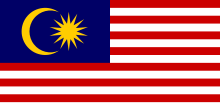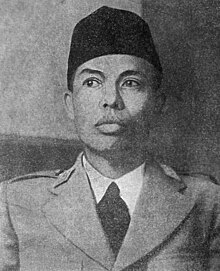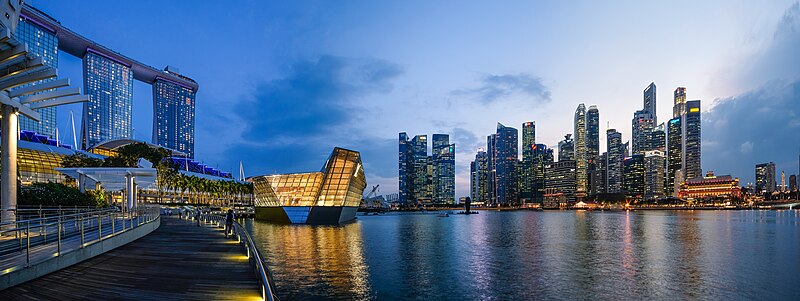Portal:Asia

 Asia (/ˈeɪʒə/ ⓘ AY-zhə, UK also /ˈeɪʃə/ AY-shə) is the largest continent in the world by both land area and population. It covers an area of more than 44 million square kilometers, about 30% of Earth's total land area and 8% of Earth's total surface area. The continent, which has long been home to the majority of the human population, was the site of many of the first civilizations. Its 4.7 billion people constitute roughly 60% of the world's population. Asia shares the landmass of Eurasia with Europe, and of Afro-Eurasia with both Europe and Africa. In general terms, it is bounded on the east by the Pacific Ocean, on the south by the Indian Ocean, and on the north by the Arctic Ocean. The border of Asia with Europe is a historical and cultural construct, as there is no clear physical and geographical separation between them. It is somewhat arbitrary and has moved since its first conception in classical antiquity. The division of Eurasia into two continents reflects East–West cultural, linguistic, and ethnic differences, some of which vary on a spectrum rather than with a sharp dividing line. A commonly accepted division places Asia to the east of the Suez Canal separating it from Africa; and to the east of the Turkish Straits, the Ural Mountains and Ural River, and to the south of the Caucasus Mountains and the Caspian and Black seas, separating it from Europe. China and India traded places as the largest economies in the world from 1 to 1800 CE. China was a major economic power for much of recorded history, with the highest GDP per capita until 1500. The Silk Road became the main east–west trading route in the Asian hinterlands while the Straits of Malacca stood as a major sea route. Asia has exhibited economic dynamism as well as robust population growth during the 20th century, but overall population growth has since fallen. Asia was the birthplace of most of the world's mainstream religions including Hinduism, Zoroastrianism, Judaism, Jainism, Buddhism, Confucianism, Taoism, Christianity, Islam, Sikhism, as well as many other religions. (Full article...) Featured articleThe Acra (also spelled Akra, from Ancient Greek: Ἄκρα, Hebrew: חקרא ,חקרה Ḥaqra(h)), with the meaning of "stronghold" (see under "Etymology"), was a place in Jerusalem thought to have had a fortified compound built by Antiochus Epiphanes, ruler of the Seleucid Empire, following his sack of the city in 168 BCE. The name Acra was also used at a later time for a city quarter probably associated with the by-then destroyed fortress, known in his time to Josephus (1st century CE) as both Acra and "the lower city". The fortress played a significant role in the events surrounding the Maccabean Revolt, which resulted in the formation of the Hasmonean Kingdom. The "upper city" was captured by Judas Maccabeus, with the Seleucid garrison taking refuge in the "Acra" below, and the task of destroying this last enemy stronghold inside Jerusalem fell to Simon Maccabeus surnamed Thassi. Our knowledge about the Acra is based almost exclusively on the writings of Josephus, which are of a later date, and on the First and Second Books of Maccabees, which were written not long after the described events. The exact location of Acra within Jerusalem, and even the meaning of the term—fortress, fortified compound inside the city, or compound with an associated fortress—is critical to understanding Hellenistic Jerusalem, but it remains a matter of ongoing discussion. The fact that Josephus has used the name interchangeably with 'the lower city' certainly doesn't help. Historians and archaeologists have proposed various sites around Jerusalem, relying initially mainly on conclusions drawn from literary evidence. This approach began to change in the light of excavations which commenced in the late 1960s. New discoveries have prompted reassessments of the ancient literary sources, Jerusalem's geography, and previously discovered artifacts. The more recent theories combine archaeological and textual evidence and favour locations near the Temple Mount and south of it, but there are alternative theories as well (see "Location"). (Full article...)Selected Country Malaysia is a country in Southeast Asia. The federal constitutional monarchy consists of 13 states and three federal territories, separated by the South China Sea into two regions: Peninsular Malaysia and Borneo's East Malaysia. Peninsular Malaysia shares a land and maritime border with Thailand and maritime borders with Singapore, Vietnam, and Indonesia. East Malaysia shares land and maritime borders with Brunei and Indonesia, as well as a maritime border with the Philippines and Vietnam. Kuala Lumpur is the national capital, the country's largest city, and the seat of the legislative branch of the federal government. Putrajaya is the administrative centre, which represents the seat of both the executive branch (the Cabinet, federal ministries, and federal agencies) and the judicial branch of the federal government. With a population of over 33 million, the country is the world's 43rd-most populous country. Malaysia is tropical and is one of 17 megadiverse countries; it is home to numerous endemic species. Tanjung Piai in the Malaysian state of Johor is the southernmost point of continental Eurasia. The country has its origins in the Malay kingdoms, which, from the 18th century on, became subject to the British Empire, along with the British Straits Settlements protectorate. During World War Two, British Malaya, along with other nearby British and American colonies, was occupied by the Empire of Japan. Following three years of occupation, Peninsular Malaysia was unified as the Malayan Union in 1946 and then restructured as the Federation of Malaya in 1948. The country achieved independence on 31 August 1957. On 16 September 1963, independent Malaya united with the then British crown colonies of North Borneo, Sarawak, and Singapore to become Malaysia. In August 1965, Singapore was expelled from the federation and became a separate, independent country. (Full article...)Featured biographySudirman (Old Spelling: Soedirman; 24 January 1916 – 29 January 1950) was a high-ranking Indonesian military officer during the Indonesian National Revolution. The first commander of the Indonesian National Armed Forces, he continues to be widely respected in the country. Born in Purbalingga, Dutch East Indies, Sudirman moved to Cilacap in 1916 and was raised by his uncle. A diligent student at a Muhammadiyah-run school, he became respected within the community for his devotion to Islam. After dropping out of teacher's college, in 1936 he began working as a teacher, and later headmaster, at a Muhammadiyah-run elementary school. After the Japanese occupied the Indies in 1942, Sudirman continued to teach, before joining the Japanese-sponsored Defenders of the Homeland as a battalion commander in Banyumas in 1944. In this position he put down a rebellion by his fellow soldiers, but was later interned in Bogor. After Indonesia proclaimed its independence on 17 August 1945, Sudirman led a break-out then went to Jakarta to meet President Sukarno. Tasked with overseeing the surrender of Japanese soldiers in Banyumas, he established a division of the People's Safety Body there. On 12 November 1945, at an election to decide the military's commander-in-chief in Yogyakarta, Sudirman was chosen over Oerip Soemohardjo in a close vote. While waiting to be confirmed, Sudirman ordered an assault on British and Dutch forces in Ambarawa. The ensuing battle and British withdrawal strengthened Sudirman's popular support, and he was ultimately confirmed on 18 December. (Full article...)General imagesThe following are images from various Asia-related articles on Wikipedia. Featured picture Credit: Muhammad Mahdi Karim An unpeeled and a peeled rambutan, the fruit of the rambutan tree. The plant is native to the Malay Archipelago and can be found through much of Southeast Asia, although its exact distribution remains unknown. The name is derived from the Malay word rambut, which literally means 'hairy'. The fruit flesh is translucent, whitish or very pale pink, with a sweet, mildly acidic flavour.
Did you know...
Updated: 6:33, 14 February 2024 In the news
Related portalsMajor Religions in Asia Middle East Central Asia and Surroundings Indian Subcontinent Southeast Asia East Asia Selected panorama
The Central Area of Singapore surrounded by the perimeter of five planning areas: the Marina Bay, the Downtown Core, Marina East, Marina South and Straits View. The area surrounding the bay itself, also called Marina Bay, is a 360 hectare extension to the adjacent CBD. It is also the new downtown of Singapore built on reclaimed land. TopicsCategoriesAssociated WikimediaThe following Wikimedia Foundation sister projects provide more on this subject:
More portalsShortcuts to this page: Asia portal • P:ASIA Purge server cache |






























































































